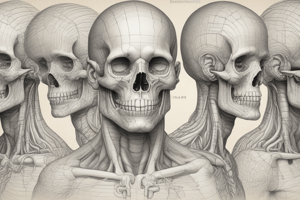Podcast
Questions and Answers
What is the primary function of bones in the human body?
What is the primary function of bones in the human body?
- To produce energy
- To absorb nutrients
- To give our body shape and keep us upright (correct)
- To provide warmth
Which part of the body is responsible for connecting the leg to the upper body?
Which part of the body is responsible for connecting the leg to the upper body?
- Rib cage
- Hip (correct)
- Spine
- Skull
What term describes the hard skins or shells found outside some invertebrates?
What term describes the hard skins or shells found outside some invertebrates?
- Scaffold
- Skeleton
- Frame
- Exoskeleton (correct)
What is the definition of an infectious disease?
What is the definition of an infectious disease?
What does the term 'contract' refer to in relation to muscles?
What does the term 'contract' refer to in relation to muscles?
Which of the following best defines 'organs' within the body?
Which of the following best defines 'organs' within the body?
What role do vaccinations play in our health?
What role do vaccinations play in our health?
What is the function of the rib cage in humans?
What is the function of the rib cage in humans?
What does the term 'predict' mean in a scientific context?
What does the term 'predict' mean in a scientific context?
Which of the following accurately defines 'predator'?
Which of the following accurately defines 'predator'?
What is a 'food chain' primarily used to illustrate?
What is a 'food chain' primarily used to illustrate?
What happens during the process of melting?
What happens during the process of melting?
What is meant by 'energy transfer'?
What is meant by 'energy transfer'?
Which of the following best describes a 'consumer'?
Which of the following best describes a 'consumer'?
What does 'change of state' refer to?
What does 'change of state' refer to?
Which of the following animals would be classified as an omnivore?
Which of the following animals would be classified as an omnivore?
Study Notes
Skeleton and Bones
- Bones are hard and strong, providing shape and support for the body.
- The skeleton is a frame made of bones that gives structure and protects vital organs.
- Key bones include the skull (head), spine (back), rib cage (chest), hip (connection between leg and body), and jaw (movable bone for eating and talking).
Muscles and Movement
- Muscles are attached to bones and enable movement through contraction (shortening and thickening) and relaxation (lengthening and thinning).
- Muscles feel different based on their state; hard when contracted and soft when relaxed.
Body Functions and Protection
- Organs perform various jobs within the body; protection is provided by bones and other structures to keep safe from harm.
- Vaccinations and medicines help prevent or treat infectious diseases caused by germs.
Energy and Its Transfer
- Energy is essential for causing movement or actions and can transfer from one object or place to another.
- Electrical appliances use electrical energy to function, illustrating a specific form of energy in daily life.
Food and Ecosystem Dynamics
- The food chain illustrates energy flow, showing relationships among producers (plants), consumers (animals), and their dietary classifications: herbivores (plant-eaters), carnivores (meat-eaters), and omnivores (eat both).
- The predator-prey relationship is critical; predators kill and eat prey to obtain energy.
Comparison and Properties of Materials
- Comparing involves examining similarities and differences between items or concepts.
- Materials have distinct properties, such as hardness in rocks or elasticity, affecting their behavior and use.
Matter and Changes
- Matter exists in different forms: solids, liquids, and gases, each identifiable by specific properties.
- A change of state occurs when matter transitions between forms due to heating (e.g., melting of solids to liquids) or cooling.
General Concepts
- Germs are tiny organisms that can cause illness and infect the body, leading to diseases.
- Instructions guide actions, such as assembling models or executing scientific investigations.
- Understanding functions and characteristics is vital for grasping how various systems and processes work.
Studying That Suits You
Use AI to generate personalized quizzes and flashcards to suit your learning preferences.
Related Documents
Description
This quiz covers key vocabulary related to human anatomy for Primary 4 science. Students will explore terminology such as bones, frame, hip, jaw, and model, which are essential for understanding how our bodies work. Prepare to test your knowledge on these fundamental concepts.





